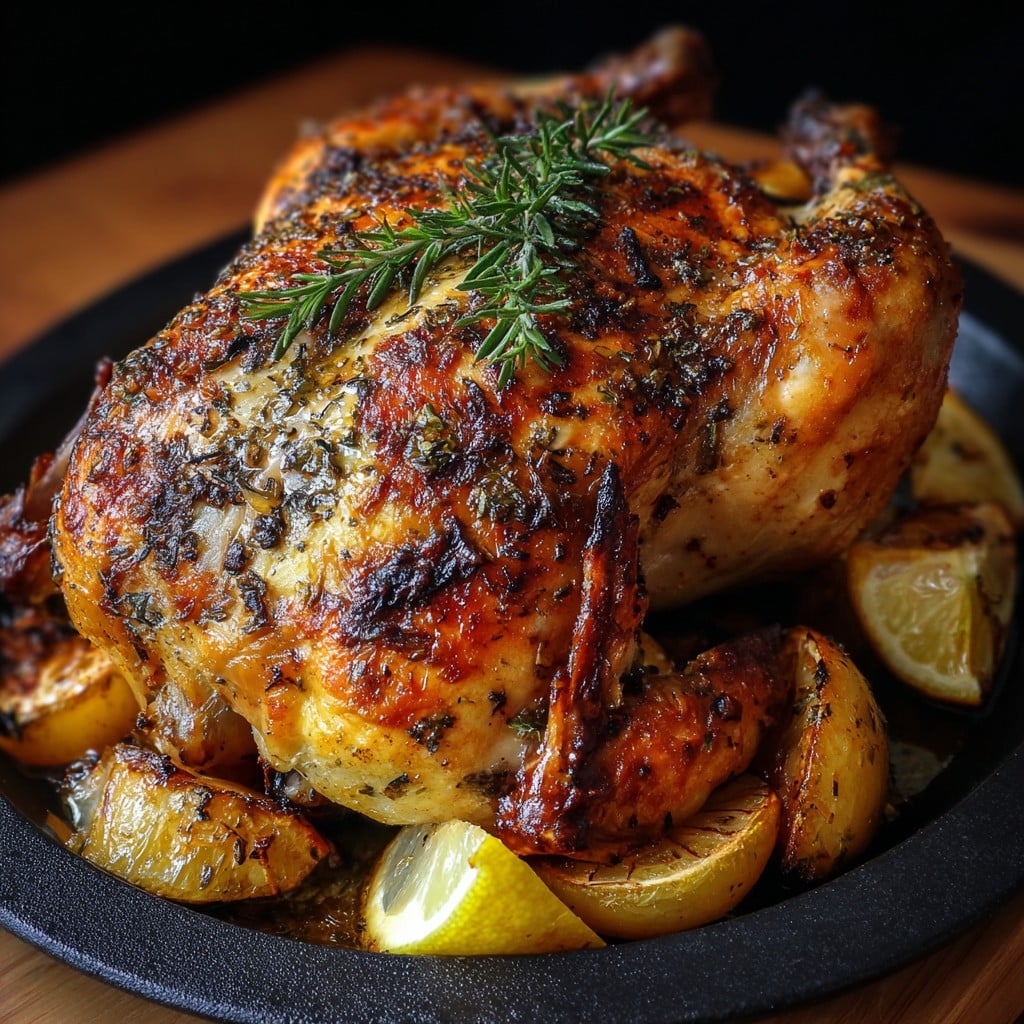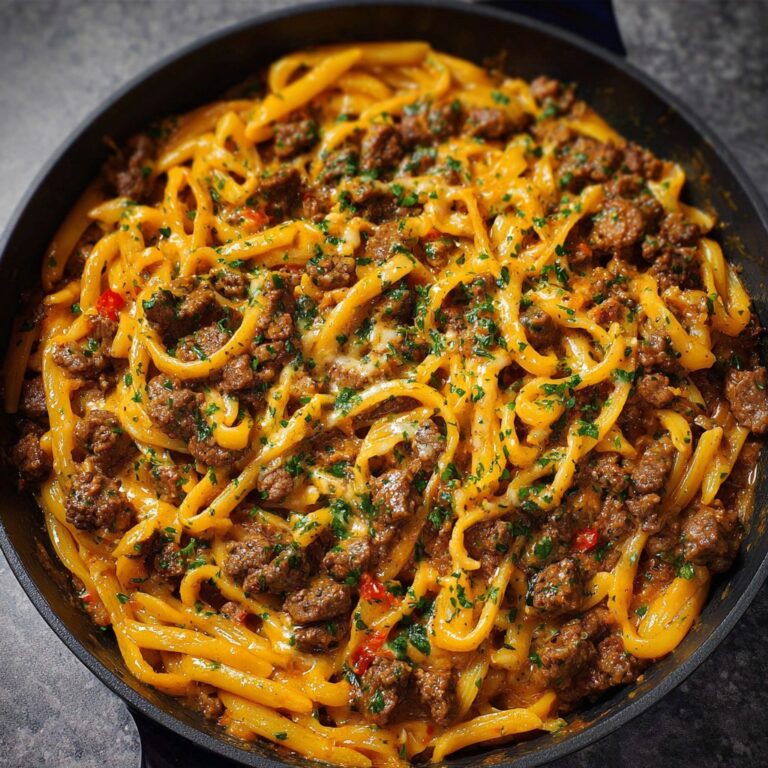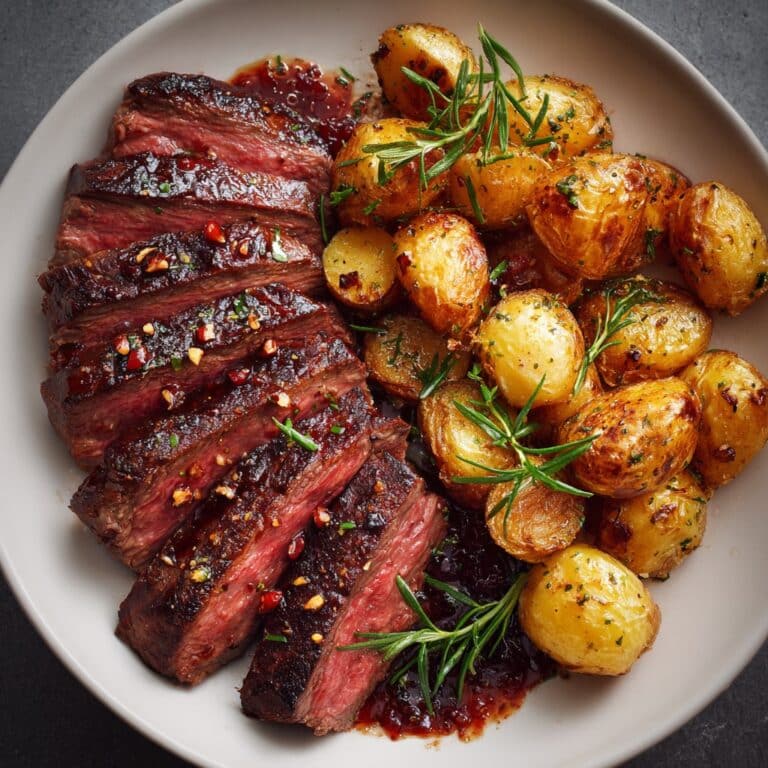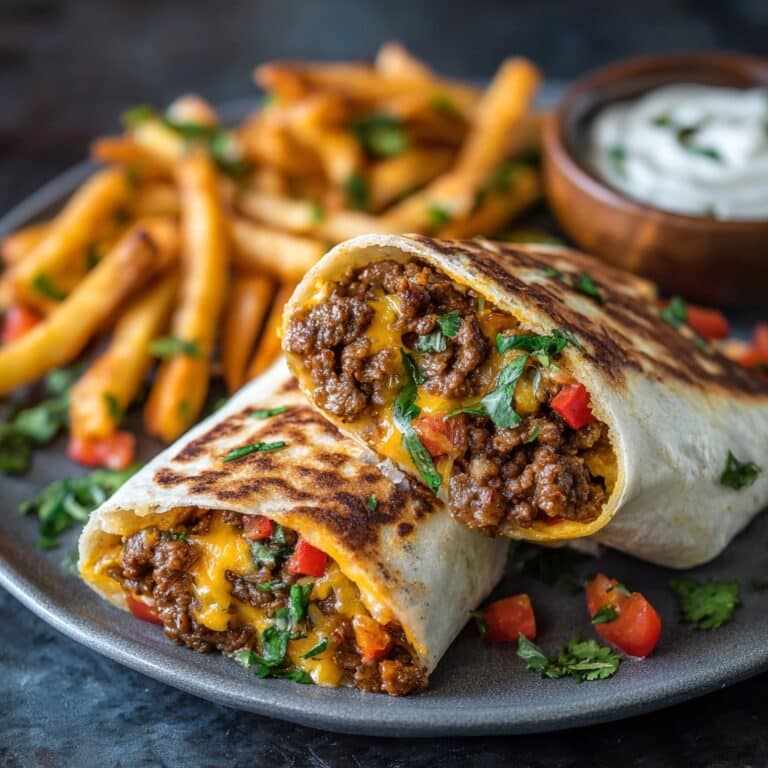Whole Roasted Chicken
Whole roasted chicken is a timeless classic that graces dinner tables around the world. Celebrated for its juicy, tender meat and golden, crispy skin, it remains a favorite centerpiece for family gatherings, celebrations, and everyday comforting meals.
The art of roasting a whole chicken dates back centuries, evolving from open-flame spit-roasting to oven-baking perfection.
The irresistible aroma of roasted chicken is familiar across many cultures, and its beauty lies in its versatility: serve it with robust vegetables, delicate sauces, or simply on its own for a satisfying meal.
Today, the whole roasted chicken is not only a staple of home cooking but also a dish featured in top restaurants globally, admired for its straightforward preparation and ability to please any palate. The simplicity of the ingredients—chicken, herbs, and basic seasonings—allows for endless flavor combinations.
According to the Food Network, a properly roasted whole chicken delivers succulent results every time, making it the hallmark of home-cooked comfort food. Whether you're hosting a special occasion or looking for meal prep ideas, learning to make whole roasted chicken ensures a delicious and impressive outcome every time.
Ingredients for Whole Roasted Chicken
- 1 whole chicken (about 4-5 pounds), giblets removed
- 2 tablespoons olive oil or melted butter
- 2 teaspoons kosher salt
- 1 teaspoon freshly ground black pepper
- 1 lemon, cut in half
- 1 whole head of garlic, halved crosswise
- 4-6 fresh thyme sprigs
- 2 fresh rosemary sprigs
- 1 onion, quartered
- 2 carrots, peeled and cut into large pieces
- 2 celery stalks, cut into large pieces
Instructions for Making Whole Roasted Chicken
- Preheat the oven to 425°F (220°C). Position a rack in the center.
- Pat the chicken dry thoroughly using paper towels, removing excess moisture for crispier skin.
- Rub the entire chicken with olive oil or melted butter, ensuring every surface is evenly coated.
- Season the chicken generously with salt and black pepper, both inside and out.
- Stuff the cavity with lemon halves, garlic, thyme, rosemary, and onion quarters.
- Arrange the carrots, celery, and any remaining onion in the roasting pan to create a base for the chicken.
- Place the chicken breast-side up on top of the vegetables in the pan.
- Tuck the wings under and, if desired, tie the legs together with kitchen twine for even cooking.
- Roast the chicken uncovered for about 70–90 minutes, or until the juices run clear and the internal temperature reaches 165°F (74°C) when checked in the thickest part of the thigh.
- If the skin browns too quickly, tent the chicken loosely with foil after 45 minutes of roasting.
- Once done, remove the chicken from the oven and let it rest for at least 15 minutes before carving to allow juices to redistribute.
- Carve the chicken and serve with the roasted vegetables and your choice of sides.
Nutritional Information
A typical serving of whole roasted chicken (approximately 3.5 ounces or 100 grams of cooked meat, skin included) provides around 200 calories. It packs 27 grams of high-quality protein, making it an excellent choice for muscle building and repair.
The fat content varies depending on how much skin is consumed, ranging from 8 to 12 grams per serving, with about 3 grams of saturated fat. Roasted chicken is low in carbohydrates and sugars, supporting low-carb and keto dietary patterns.
It’s also an abundant source of vital nutrients: niacin (B3), phosphorus, selenium, and vitamin B6, which are essential for metabolism, bone health, and immune function. If you wish to reduce calories and fat, simply remove the skin before eating.
Pairing your whole roasted chicken with lots of vegetables further boosts the fiber and micronutrient content of your meal. For comprehensive nutritional information and daily values, refer to the USDA FoodData Central (https://fdc.nal.usda.gov/fdc-app.html#/food-details/169842/nutrients), which offers breakdowns for various chicken preparations.
Always remember that preparation methods and added ingredients can alter these totals, so adjust accordingly based on your ingredients and serving sizes.
Wine/Beverage Pairings With Whole Roasted Chicken
Whole roasted chicken pairs beautifully with a variety of beverages, allowing you to choose based on your preferences and those of your guests. A classic white wine such as Chardonnay, with its oaky notes and balanced acidity, complements the dish’s savory richness and crisp skin.
For those who prefer red wine, a Pinot Noir offers gentle tannins that won’t overpower the chicken’s flavor. Rosé, both still and sparkling, brings a refreshing brightness that pairs well with the herbs and citrus in your chicken.
Non-alcoholic options such as sparkling apple cider, ginger ale, or a homemade lemonade infused with thyme also provide excellent pairings, cutting through any richness and keeping the palate refreshed.
Cooking Tips and Variations
Achieving the perfect whole roasted chicken involves attention to a few key techniques. First, make sure your chicken is completely dry before seasoning—this promotes ultra-crispy skin. Allowing the chicken to rest at room temperature for 30 minutes before roasting can help it cook more evenly.
Choosing a high-quality chicken, such as organic or pasture-raised, can enhance both flavor and texture. For deeper flavors, consider dry brining: rubbing the chicken with salt and refrigerating uncovered for several hours or overnight. You can customize your roast with various herbs and seasonings—try sage, oregano, smoked paprika, or cumin.
Stuffing the cavity with aromatics like citrus, fresh herb bundles, or apple slices infuses subtle layers of flavor. If you prefer vegetables with more caramelization, roast them on a separate tray.
Keep a meat thermometer handy to avoid overcooking: the thigh should reach 165°F (74°C), but letting it climb slightly higher near the bone is fine for extra tenderness. For a twist, glaze your chicken in the last 10 minutes with a honey or balsamic mixture.
For more roasting tips, check out Serious Eats’ guide to perfect roast chicken (https://www.seriouseats.com/how-to-roast-a-chicken-best-easy-roast-chicken-recipe). With these tips, your whole roasted chicken will delight every time.
Serving Suggestions
Serving whole roasted chicken allows for creative and visually stunning presentations. Once your chicken has rested after roasting, carve it by removing the legs and thighs first, followed by the wings, then slice the breast meat.
Arrange the meat artistically on a platter alongside your roasted carrots, celery, and onions to showcase the meal’s rustic charm. For added color and freshness, garnish with sprigs of fresh thyme or flat-leaf parsley and thin lemon slices.
Whole roasted chicken is exceptionally versatile with side dishes—a medley of seasonal roasted vegetables, buttery mashed potatoes, or a crisp green salad all make fitting accompaniments. For a family-style meal, serve the chicken with homemade gravy and a basket of warm bread.
If entertaining, provide an elegant sauce such as a white wine reduction or herbed chimichurri for guests to drizzle as desired. Consider pairing with rice pilaf or traditional stuffing during festive occasions.
No matter the context, ensure you’ve warmed your plates and offer plenty of napkins, as the juicy, flavorful meat is meant to be savored—and sometimes enjoyed with your hands.
Presentation matters: a roasted chicken arranged whole at the table allows your guests to appreciate the golden skin and aromatic herbs before carving. This simple yet impressive dish brings people together and promises warmth and abundance.

Whole Roasted Chicken Health Benefits
Whole roasted chicken delivers a wealth of nutritional benefits, especially when prepared with simple, whole-food ingredients. It’s naturally rich in complete protein, providing all essential amino acids required for growth, repair, and overall well-being.
Roasted chicken is an excellent source of B vitamins (notably niacin and vitamin B6), which support energy production and nervous system health. The inclusion of potassium, phosphorus, and selenium helps regulate cell function and protect against oxidative stress.
Because whole roasted chicken is roasted rather than fried, the finished dish is lower in added fats and calories—a boon for those watching their intake. Retaining the skin for roasting adds moisture and flavor, but removing it before eating reduces saturated fat and cholesterol levels.
Roasting with plenty of vegetables further enhances the health benefits by increasing fiber and antioxidant intake, which has been associated with heart health and improved digestion.
Learn more about the health advantages of chicken in Harvard’s School of Public Health synopsis (https://www.hsph.harvard.edu/nutritionsource/food-features/chicken/). Moderate, balanced consumption of whole roasted chicken supports a nourishing and wholesome diet.
FAQs About Whole Roasted Chicken
How do I ensure my whole roasted chicken stays juicy?
Pat your chicken dry, rub it with oil or butter, and roast at a high temperature. Let it rest for at least 15 minutes after roasting to retain juices.
Should I cover the chicken during roasting?
No, roast uncovered for crispy skin. If it browns too quickly, loosely tent with foil after about 45 minutes.
Can I use different herbs or spices?
Absolutely. Whole roasted chicken is very versatile. Customize with your favorite fresh or dried herbs, spices, or even citrus fruits.
What is the best internal temperature for roasted chicken?
The thigh’s thickest part should reach 165°F (74°C) for safe consumption. Use a meat thermometer for accuracy.
How long does leftover roasted chicken keep?
Store leftovers in an airtight container in the refrigerator for up to 4 days, or freeze for up to 3 months.
Mastering the whole roasted chicken is a rewarding skill for any home cook. With just a few foundational techniques and quality ingredients, you can deliver a show-stopping meal that’s both nutritious and deeply satisfying. This straightforward recipe enables you to explore creative seasonings, customize side dishes, and serve a main course that delights guests and family alike. Whether as a cozy weeknight dinner or the star of a festive celebration, whole roasted chicken brings warmth and togetherness to the table. Enjoy the process and savor each bite—it’s a classic for good reason.
Ingredients
- 1 whole chicken (about 4 pounds)
- 2 tablespoons olive oil
- 1 tablespoon kosher salt
- 1 teaspoon black pepper
- 1 lemon, halved
- 4 garlic cloves, smashed
- 2 sprigs fresh rosemary
- 2 sprigs fresh thyme
Instructions
-
1Preheat your oven to 425°F (220°C). Pat the chicken dry with paper towels.
-
2Rub the chicken all over with olive oil, salt, and black pepper. Stuff the cavity with lemon halves, garlic, rosemary, and thyme.
-
3Place the chicken breast-side up on a rack in a roasting pan.
-
4Roast the chicken in the preheated oven for about 1 hour and 30 minutes, or until the juices run clear and a thermometer inserted into the thickest part reads 165°F (74°C).
-
5Let the chicken rest for 10-15 minutes before carving. Serve warm.
Approximate Information for One Serving
Nutrition Disclaimers
Number of total servings shown is approximate. Actual number of servings will depend on your preferred portion sizes.
Nutritional values shown are general guidelines and reflect information for 1 serving using the ingredients listed, not including any optional ingredients. Actual macros may vary slightly depending on specific brands and types of ingredients used.
To determine the weight of one serving, prepare the recipe as instructed. Weigh the finished recipe, then divide the weight of the finished recipe (not including the weight of the container the food is in) by the desired number of servings. Result will be the weight of one serving.
Did you make this recipe?
Please consider Pinning it!!







